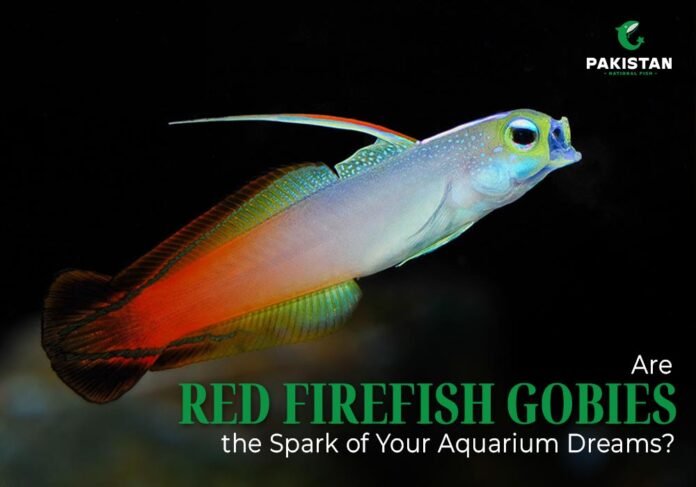If you’re dreaming of a vibrant, lively aquarium that bursts with color and personality, the blue hippo tang fish (Paracanthurus hepatus) might already be on your radar, thanks to its dazzling cobalt hues and Finding Nemo fame. But let’s turn the spotlight to another gem of the reef: the red firefish goby (Nemateleotris magnifica). This fiery little dartfish, with its yellow head, white midsection, and flaming orange-red tail, is a showstopper that’s as charming as it is manageable for aquarists of all levels.
Whether you’re a newbie dipping your toes into marine tanks or a seasoned hobbyist, the red firefish goby—along with its cousins like the scissortail goby and other dartfish—brings a unique flair to your underwater world. In this blog, we’ll dive deep into how to care for these stunning fish, answer your burning questions, and share some magical tips to keep your aquarium thriving. Ready to make a splash? Let’s get started!
Table of Contents
Quick Information:
| Care Level | Temperament | Color Form | Diet | Family | Water Conditions | Max. Size |
|---|---|---|---|---|---|---|
| Easy | Peaceful | Orange, Red, White, Yellow | Carnivore | Gobiidae | sg 1.020-1.025, 72-78°F, dKH 8-12, pH 8.1-8.4 | 3″ |
What Makes the Red Firefish Goby So Special?
The red firefish goby, or Nemateleotris magnifica, is like the rockstar of nano reef tanks. Its vibrant colors—yellow head fading into a white body and a fiery orange-red tail—make it a standout, but it’s the personality that seals the deal. These little guys hover gracefully over reefs, darting into hiding spots with the speed of a lightning bolt, earning their nickname dartfish. They’re peaceful, reef-safe, and perfect for smaller setups, but they come with a few quirks you’ll want to know about.
Here’s why they’re a must-have:
- Eye-catching colors: The gradient from yellow to red is like a sunset in your tank.
- Playful behavior: They hover and dart, adding movement and life to your aquarium.
- Beginner-friendly: Hardy and low-maintenance, they’re great for new aquarists.
- Reef-safe: They won’t nibble on your corals or bother invertebrates.
But heads-up: these fish are notorious jumpers, so a tight-fitting lid is non-negotiable
But heads-up:
These fish are notorious jumpers, so a tight-fitting lid is non-negotiable
What Are the Scientific Names of These Aquarium Gems?
Common Name | Scientific Name |
Red Firefish Goby | Nemateleotris magnifica |
Purple Firefish | Nemateleotris decora |
Exquisite Firefish | Nemateleotris exquisita |
Helfrich’s Firefish | Nemateleotris helfrichi |
Scissortail Goby | Ptereleotris trilineata |
Blue Hippo Tang | Paracanthurus hepatus |
How Do You Set Up the Perfect Tank for a Firefish Goby?
Creating a cozy home for your aquarium firefish is key to keeping them happy and stress-free. These fish are small (up to 3 inches), but their active, darting nature means they need space and specific conditions. Here’s how to set up their dream tank:
- Tank Size: Start with a 20-gallon tank for a single firefish or a mated pair. If you’re adding a scissortail goby or other dartfish, go for 30 gallons or more to reduce territorial spats.
- Substrate: Use fine, soft sand for burrowing. Firefish love to dig little hideaways to sleep in or retreat to when spooked. Rough gravel can scrape their delicate bodies.
- Hiding Spots: Include caves, crevices, or PVC pipes for bolt-holes. Firefish need safe spots to dart into when stressed. Live rock or hard corals work great.
- Water Parameters:
- pH: 8.1–8.4
- Salinity: 1.020–1.025
- Hardness: 8–12 dGH
- Temperature: 72–78°F
- Lighting and Current: Moderate lighting and a gentle to moderate current mimic their natural reef habitat. Avoid strong currents, as they prefer calmer waters.
- Lid Up: Firefish are Olympic-level jumpers. A secure lid or netting is a must to prevent them from taking a leap of faith onto your carpet.
Tip:
Add some live rock with natural algae growth. It not only looks stunning but also provides a natural food source for your firefish to nibble on.
What Should You Feed Your Aquarium Firefish?
Firefish gobies are omnivores with a taste for tiny, meaty morsels and some plant-based snacks. Feeding them right keeps their colors vibrant and their energy high. Here’s how to keep their bellies full:
- Diet Staples:
- Live or frozen foods: Brine shrimp, mysis shrimp, and copepods are their favorites.
- Commercial foods: High-quality marine flakes or pellets enriched with vitamins.
- Algae-based options: Spirulina flakes or seaweed for variety.
- Feeding Frequency: Feed 2–3 times daily in small amounts. Their tiny stomachs can’t handle big meals.
- Pro Tip: Scatter food across the tank to ensure your firefish gets its share, as they can be outcompeted by bolder tank mates.
Tip:
If your firefish is shy, try feeding at dusk when they’re more active. A small feeding ring can also help keep food from drifting away.
Who Are the Best Tank Mates for Dartfish?
Firefish and scissortail gobies are peaceful, but they’re also timid, so choosing the right tank mates is crucial. They thrive in community tanks with non-aggressive fish of similar size. Here’s a quick guide:
- Great Tank Mates:
- Clownfish (Amphiprion spp.)
- Green Chromis (Chromis viridis)
- Pajama Cardinalfish (Sphaeramia nematoptera)
- Blennies (Ecsenius spp.)
- Small invertebrates like cleaner shrimp
- Avoid These:
- Aggressive fish: Triggerfish, lionfish, large angelfish, or dottybacks.
- Semi-aggressive fish: Yellow tangs or blue tangs (Paracanthurus hepatus) can bully them, especially in smaller tanks.
- Firefish with Firefish: Stick to one firefish per tank unless you have a mated pair or a very large tank (75+ gallons). They’re territorial with their own kind and can fight to the death.
Tip:
Add firefish early in your tank’s stocking plan to let them establish their territory before introducing bolder fish.
How Can You Keep Your Firefish Goby Healthy?
Firefish are hardy, but they’re sensitive to stress and poor water quality. Here’s how to keep them thriving:
- Monitor Water Quality: Regular testing for pH, salinity, and ammonia is a must. Poor water conditions can lead to stress and disease.
- Watch for Ich: Firefish are prone to saltwater ich (white spots). If you spot scratching or white dots, treat with copper sulfate or a quarantine tank.
- Reduce Stress: Provide plenty of hiding spots and avoid overcrowding. Stress can cause firefish to stop eating or jump out of the tank.
- Quarantine New Fish: Always quarantine new arrivals to prevent introducing diseases. Firefish are hardy but not immune.
Magic Tip:
Keep a small hospital tank ready for emergencies. It’s a lifesaver for treating sick fish without disrupting your main tank.
What Are the Quirks of Scissortail Gobies?
The scissortail goby (Ptereleotris trilineata) is another dartfish that’s a bit less flashy than the red firefish but just as captivating. With its silvery body and distinctive forked tail, it’s a schooling fish that loves to hover in groups. Here’s what you need to know:
- Tank Requirements: Similar to firefish, they need a 20-gallon tank with fine sand and hiding spots. They prefer moderate currents and open swimming space.
- Behavior: Scissortails are peaceful and can be kept in small groups, unlike firefish. They’re less territorial but still need a lid to prevent jumping.
- Diet: They eat the same foods as firefish—brine shrimp, mysis, and flakes—but may need more frequent feeding in a group.
- Lifespan: With good care, they can live 2–3 years, though stress or jumping can shorten this.
Magic Tip:
Pair scissortail gobies with other schooling fish like green chromis for a mesmerizing display of synchronized swimming.
Curious Minds Want to Know: Your Firefish Questions Answered
Conclusion: What’s Next for Your Aquarium Adventure?
The red firefish goby, scissortail goby, and other dartfish are like little sparks of joy in your aquarium, blending vibrant colors with quirky behaviors. By setting up the right tank, feeding them well, and choosing compatible tank mates, you’ll create a thriving underwater world that’s as fun to watch as it is to care for.
But the adventure doesn’t stop here! In our next blog, we’ll explore the dazzling world of clownfish and their anemone pals—perfect companions for your firefish. Stay tuned for more tips, tricks, and aquatic magic to keep your tank glowing!
What’s your favorite fish to pair with a firefish goby? Drop your thoughts below and let’s keep the aquarium love flowing!


